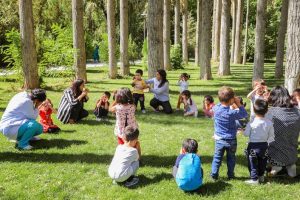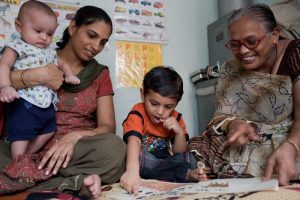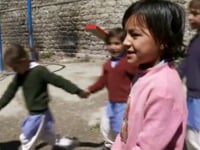2.3 Early child development programs

Bronfenbrenner’s model provides a useful framework for studying various settings (or microsystems) and the impact they have on young children. On page 2.1, research about children’s home lives was explored. The prevalence of early child development (ECD) programs means that the effect of these settings on young children also needs to be better understood. ECD programs vary widely in content, targeted participants, and intensity.
While all children benefit from ECD, research indicates that the most vulnerable children benefit the most from access to quality early childhood education. Access to ECD programs is an issue in most parts of the world but is a particular issue for children in low-income countries.
Today, 50 per cent of pre-primary-age children around the world – at least 175 million – are not enrolled during these crucial years in pre-primary education. In low-income countries, only one in every five children has access to pre-primary education. Those who are the least likely to attend early childhood education programmes would benefit from them the most” (UNICEF, 2017, p. 6).
Access is important based on the growing recognition, and what some have suggested is “global consensus”, about the importance of high-quality ECD programs for children’s educational achievement Cardini et al. (2019, para. 1). In the next article, the authors state that “it takes more than a village”, as they frame ECD as part of a complex system, involving various organizations and sectors. They present an interesting discussion about the importance of both local communities and cross-sectoral cooperation and coordination.
The worldwide statistics about access to ECD programs are alarming. Does this seem to reflect access in your community or country?
What are the other sectors, organizations in the broad system in your community?
What needs to be done to strengthen both individual ECD programs and the broader system?
Bronfenbrenner’s ecological model also helps in understanding the importance of connections or links between children’s homes or families and the ECD programs they may attend. Teachers and caregivers have expertise in child development and in providing appropriate programs for young children – but families are experts too. Families know their children best.

Various ways these settings can be connected, or integrated, strengthens both the home and the ECD program – and ultimately promotes the best possible outcomes for children. In the Brain Development module, the reach and effectiveness of integrating ECD initiatives in the health care sector, particularly in fostering the development of children 0-3, was presented. ECD programs are increasingly being integrated with other services and programs to effectively work together to reach children and families
A pilot program by UNICEF-China in partnership with the All China Women’s Federation (ACWF), focused on integrated community-based early child development programming for children up to three years of age.
Listen as Dr. Chen Xuefeng, early childhood development specialist, UNICEF China, provides a brief description of the pilot project.
The following reading by Chen and Qi Zhao (2019) provides further background to the project, information about the approach taken, and the resulting benefits to children, their caregivers, and communities.
In the next video, listen to Chen Xuefeng stress the importance of reflecting the local community and culture in their early childhood services.
As our collective understanding of the importance of early child development grows, we want to promote ECD programs that make a difference. What is it about particular programs or settings that have a positive effect on children? What kinds of strategies, resources, or supports are most effective? How are programs embedded in the community and culture? How are programs integrated with children’s families, and with other programs or services in the community?
Countless ECD programs exist throughout the world, many are highlighted in various SECD modules. The following readings provide an overview of five early childhood education programs that have been researched and evaluated and been shown to promote early child development and learning. The studies/programs profiled are:
- Crece Contigo, Chile
- Early Childhood Home Visiting Intervention, Jamaica
- Mother Child Education Program (MCEP), Turkey
- Releasing Confidence and Creativity, Pakistan
- Carolina Abecedarian Project, U.S.A.
As you learn about these programs, consider the five components of the Nurturing Care Framework (explored on page 1 of this module): good health, adequate nutrition, safety and security, opportunities for early learning, and responsive caregiving. What components of nurturing care are covered in these programs? What components of nurturing care are not covered or not fully covered? How would you enhance these programs to include these missing elements? For parents to be able to provide nurturing care, they also need nurturing care. How do the programs nurture parents?
Crece Contigo, Chile
The Chile Crece Contigo (“Chile Grows With You”) program is an example of what was essentially an integrated system designed to support child well-being. The program included free access to nurseries and preschools for the most vulnerable children, but also included an array of health, community, and social services and programs. The program began with the mother’s first prenatal check-up and followed the child until age four (this was later extended to age nine).
Explore the following website to learn more about Chile Crece Contigo.
The next two articles highlight the multisectoral collaboration between health, science, and education. The first is by Milman et al. (2018), the second by the World Bank. Note the key components of the program and the progression of the various program components over ten years of implementation.
What are the key lessons learned over the 10 years of implementation?
Loewenson et al. (2019) use Chile Crece Contigo in a case study that explores policy shifts in Chile.
Early Childhood Home Visiting Intervention, Jamaica
The Jamaica Home Visit Programme, initially designed for stunted children, was an intervention that included both nutrition and psychosocial stimulation. Dr. Susan Walker, director of the Caribbean Institute for Health Research at the University of the West Indies, provides an overview of both the program and the benefits it provided children. In the second video, Walker expands on specific components or facts that contribute to the effectiveness of this program.
The Jamaica Home Visit Programme has been adapted, replicated, and rigorously evaluated for more than thirty years. Read the following Early Childhood Matters article for a detailed review of this program and for an overview of key research evidence.
Why was home visiting chosen for this intervention, rather than a center-based intervention?
The researchers state that the overall philosophy of the intervention is to “support mothers to promote their children’s development”. How is this evident through the various adaptations of the program?
How were the researchers responsive to the family and community?
The authors report that this intervention was replicated in Bangladesh and Colombia. What important factors do the researchers identify as important considerations for other countries as they adapt such a program to a new culture?
Based on the well-documented success of the Jamaica Home Visit Programme, Dr. Susan Walker and others at the University of the West Indies developed Reach Up, an early childhood parenting package. The Reach Up website provides information about curricula, manuals, templates, and training that are part of this program.
Mother Child Education Program, Turkey
The Mother Child Education Program (MOCEP) is a home-based preschool education designed for mothers of five and six-year-old children without access to preschool. It was developed to support mothers in their parenting roles and equip them with the knowledge and tools necessary to foster their children’s early learning prior to school entry. The next readings are included in “Effective Early Childhood Programmes” (Early Childhood in Focus 4) and provide a summary of the program and its effectiveness.
The next video provides an overview of the mothers’ training. as well as the increasing role of fathers in the program. Three case studies highlight the unique experiences of past and present participants in the program. MOCEP became institutionalized in Turkey. It has been translated and replicated by NGOs working with children and families in numerous European, Middle Eastern, and Latin American countries.
What types of benefits did this study demonstrate beyond cognitive advances for the children?
MOCEP has been the subject of a number of research studies that have followed children to the age of 22. Hilal Gencay of the Mother Child Education Foundation (ACEV) presents key findings for both children and mothers.
Releasing Confidence and Creativity (RCC), Pakistan
Releasing Confidence and Creativity (RCC) was an initiative coordinated by the Aga Khan Foundation Pakistan (2002-2011) designed to address the access to and quality of ECD programs and early primary classes. The following reading provides background information as well as a description of the findings and challenges of the study.
Despite the various challenges described in assessing the research, in comparing RCC schools and comparison schools, what did the findings indicate regarding the classroom environments? What about children’s learning outcomes?
What do these findings tell us about good learning environments for children?
What were some of the “ripple effects” of the program on families, the research assistants, and the community?
In the following video, teachers and others involved in RCC describe the initiative and several of the programs in Gilgit-Baltistan are highlighted.
In the next presentation, Sadaf Shallwani reports on the key findings from Year 2 of the study examining the classroom environments and children’s learning outcomes between RCC schools and comparison schools in the province of Sindh.
Carolina Abecedarian Project, U.S.A.
The Carolina Abecedarian Project in the United States is an intervention study that looked at whether high-quality child care and parenting supports from infancy to age five for children from poor backgrounds increase their likelihood of school success. The Abecedarian is one of three landmark U.S. studies that are often referenced as economic evidence for investing in the early years.
In the next two videos, Dr. Joe Sparling, one of the investigators and developers of the program, discusses the findings of the Abecedarian project as the original participants are reaching 40 years of age.
What does this study tell us about the impact of early experience?
According to the research findings, do experiences after early childhood have any impact on children’s skills and abilities?
Why is this study considered to be a high quality research study?
Sparling attributes the positive long term results to the educational program that was embedded in the Abecedarian project.
What does this collection of studies tell us about the impact of early experience?
What is it that makes particular programs effective?
According to the research findings from these studies, do experiences after early childhood have any impact on children’s skills and abilities?
What are the common findings of the influence of parenting and home environments for preschool children?
Cultural context and designing programs
There is much to learn from research studies, but also much to learn from the various programs families and communities have designed and implemented around the world. Families and communities want what is best for their children – so may be tempted to replicate evidence-based programs in their communities. Should these programs be replicated? Should they be adapted for the local context? In the next video, Caroline Arnold, former education director for the Aga Khan Development Network, reflects on this question and provides an important perspective. She highlights the importance of cultural context and designing programs to build on local knowledge and expertise.
In Kyrgyz, the Aga Khan Foundation (AKF) focused on a “multi-pronged, bottom-up approach” in developing a nurturing care strategy. Communities and local government leaders were consulted with, and engaged in, planning and developing the strategy in order to effectively reach young children and families in their context.
Are you aware of other examples of ECD programs that have a strong foundation in the local cultural context?
What can you take from the highlighted research studies? Can they be applied in your setting?



